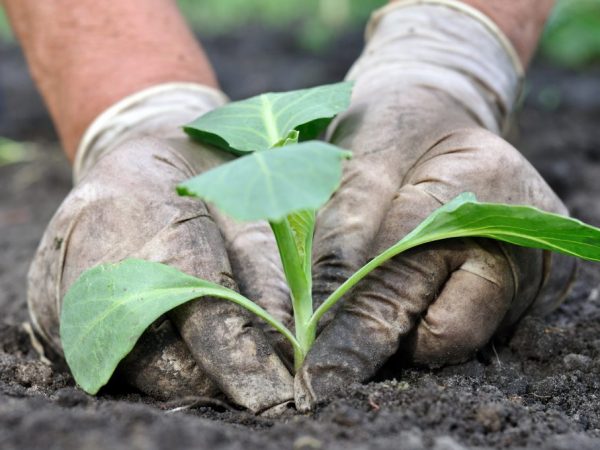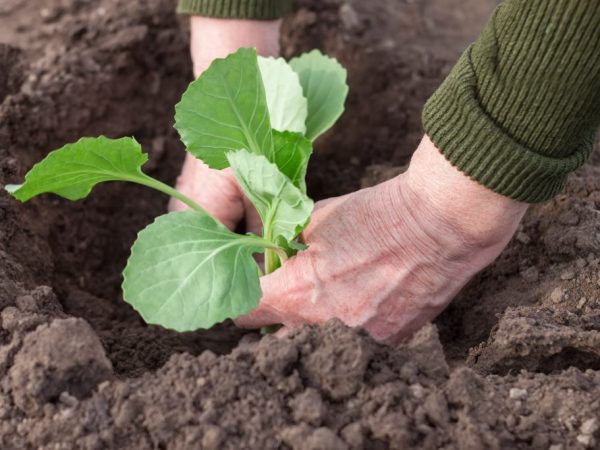What you need to put in the hole when planting cabbage
Only the correct planting of vegetables ensures the success of the cultivation. Various fertilizers are placed in the hole when planting cabbage. This stimulates growth and protects the plant from diseases and pests.

Fertilizing cabbage at the time of planting
What is put in the holes with cabbage
When planting cabbage, the following substances are placed in the planting holes:
- organic or mineral fertilizers;
- fungicides and insecticides;
- chalk, lime, dolomite flour.
Why add fertilizer
Ideally, the site is prepared in the fall, but this rule does not apply on soils that are poor in organic matter. The need to add other substances to the wells is due to the following reasons:
- the soil is poor in useful micro- and macroelements;
- acidic soil;
- reducing the risk of seedling disease.
Fertilization and soil preparation for cabbage
For seedlings to grow well and form a healthy crop, they need nutrients. Manure, compost, humate, as well as potassium-phosphorus mineral fertilizers are applied to the beds: superphosphate, potassium monophosphate, aggrecol, etc.
Fertilization rate per hole:
- Manure - 1 tbsp. without top.
- Compost - 1 tbsp.
- Potassium humate - 1 tbsp l.
- Phosphates - 0.5 tsp
The overripe manure is placed on the bottom, then lightly sprinkled with earth and well watered with water: 1 liter per 1 hole. The depth of the planting hole should be about 15 cm.
Compost is a natural organic fertilizer. It is added to the hole, watered with water and planted on top of seedlings.
Potassium humate is a kind of concentrated compost, so little is needed. Humates not only nourish plants with useful elements, but also stimulate their growth, increase immunity and resistance to infections. It is poured to the bottom when landing.
Phosphates and potassium-phosphate compounds are concentrated complex mineral fertilizers. They are necessary for building up the root system, stimulating the growth of the aerial part and replenishing the deficiency of nutrients in the soil. For feeding 0.5 tsp. mixed with the ground when planting seedlings.
Decrease in soil acidity

The future harvest depends on the quality of the soil.
Cabbage does not grow well in acidic soils, and, moreover, the risk of Keela disease increases. Keela is a fungal disease that affects the root system. In cruciferous plants, it appears as spherical growths on the roots. As a result, the growth of the culture is inhibited, development stops, and the bush may die. If the top remains green, the ovary is unlikely to form.
To lower the acidity, wood ash is added: 1 tbsp. to the landing pit. Ash is replaced with lime or dolomite flour. Lime is added at the rate of 30 g / m². Lime is not applied deeply in order to have a positive effect from its use. It is simply mixed with earth.
Dolomite flour has a weaker effect, more is required, but it is also a fertilizer. To enhance the effect, it is combined with copper sulfate or boric acid.
Complex useful compounds are prepared from fertilizers and ash, lime. Here is some of them:
- 1 tbsp. manure and 2 tbsp. l.ash is mixed and then poured with water;
- 1 tbsp. manure is mixed with 1 tsp. ash and 0.5 tsp. superphosphate.
Lime must not be mixed with ammonium nitrate and manure. It is recommended to apply it in the fall or spring, before the start of planting work.
Soil disinfection
In addition to nutrients, the earth accumulates spores of fungi, bacteria, insect eggs, beetle larvae. They can cause significant damage to the crop.
For disinfection from pests, insecticides are used:
- Zemlin;
- Force;
- Initiative.
They are used according to the manufacturer's instructions. These preparations are used not only for cabbage, but also for a number of other crops.
To fight infections in the spring, a month before planting seedlings, a 2% solution of carbation is applied to the site. The wells are watered with Fitosporin. Fungistop showed good results. They spray the area before planting.
Among the complex insectofungicides, the following drugs are distinguished:
- Trichodermin;
- "Phytodoctor";
- Mikosan;
- "Planzir".
The disadvantage of these drugs is that micro doses are introduced into the wells and it is not always convenient to calculate them.
Conclusion
A hole for planting cabbage must be prepared so as not to be left without the desired harvest in the fall. Depending on the purpose, biological or chemical preparations are used. Fertilizers are added taking into account their compatibility. If there is already an infection in the garden, the use of modern fungicides and the observance of crop rotation are mandatory.


